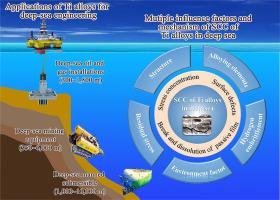Perspective review on factors that influence the stress corrosion of Ti alloys for deep-sea applications
IF 14.3
1区 材料科学
Q1 MATERIALS SCIENCE, MULTIDISCIPLINARY
引用次数: 0
Abstract
This paper reviews the current state of knowledge and advances on the stress-corrosion cracking (SCC) of Ti alloys subject to harsh corrosive environments in the deep sea, and presents the knowledge gaps and future directions. A comprehensive review of classifications and applications of Ti alloys for deep-sea engineering indicates that the near-α and α + β Ti alloys with high strength and great weldability are the primary selection for deep-sea equipment. The role of residual stress, microstructure types, alloying elements and corrosive environmental factors on SCC performance of Ti alloys are also summarised. It is revealed that the Ti alloys with Widmanstatten structure show the lowest SCC susceptibility, and alloying of Nb, Mo and Al elements plays a positive role in the boost corrosion resistance of passive film. Synergistic effects of environmental deep-sea factors include high hydrostatic pressure, low dissolved oxygen content, low temperature and decreasing pH levels intensify the SCC of Ti alloys by inducing local dissolution of the passive film and facilitating hydrogen-induced cracking at crack tip. The study also highlights future research requirements in SCC of Ti alloys in deep sea: including the set-up of unified and suitable methods of in-situ and simulated experiments, modeling and predicting of SCC behaviour in real situations, and exploring practical protective strategies specifically. These findings provide a reference for further SCC mechanisms research and promote the microstructure optimisation and performance improvement of the advanced Ti alloy-based material systems for deep-sea engineering.

透视影响深海应用钛合金应力腐蚀的因素
本文回顾了有关深海恶劣腐蚀环境下 Ti 合金应力腐蚀开裂 (SCC) 的知识现状和进展,并提出了知识差距和未来发展方向。对深海工程中 Ti 合金的分类和应用的全面回顾表明,具有高强度和高焊接性的近α 和 α + β Ti 合金是深海设备的主要选择。研究还总结了残余应力、微观结构类型、合金元素和腐蚀环境因素对 Ti 合金 SCC 性能的影响。结果表明,具有 Widmanstatten 结构的 Ti 合金显示出最低的 SCC 易感性,而 Nb、Mo 和 Al 元素的合金化对提高被动膜的抗腐蚀性能起到了积极作用。高静水压、低溶解氧含量、低温和 pH 值下降等深海环境因素的协同效应通过诱导被动膜的局部溶解和促进裂纹尖端的氢致开裂,加剧了钛合金的 SCC。该研究还强调了深海中钛合金 SCC 的未来研究需求:包括建立统一、合适的原位和模拟实验方法,对实际情况下的 SCC 行为进行建模和预测,以及具体探索实用的保护策略。这些发现为进一步开展 SCC 机理研究提供了参考,并促进了深海工程中基于先进 Ti 合金的材料系统的微观结构优化和性能改进。
本文章由计算机程序翻译,如有差异,请以英文原文为准。
求助全文
约1分钟内获得全文
求助全文
来源期刊

Journal of Materials Science & Technology
工程技术-材料科学:综合
CiteScore
20.00
自引率
11.00%
发文量
995
审稿时长
13 days
期刊介绍:
Journal of Materials Science & Technology strives to promote global collaboration in the field of materials science and technology. It primarily publishes original research papers, invited review articles, letters, research notes, and summaries of scientific achievements. The journal covers a wide range of materials science and technology topics, including metallic materials, inorganic nonmetallic materials, and composite materials.
 求助内容:
求助内容: 应助结果提醒方式:
应助结果提醒方式:


